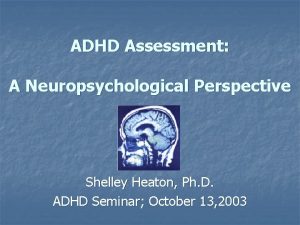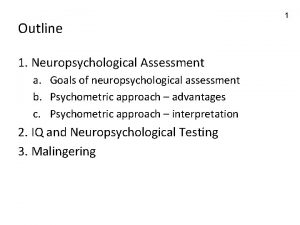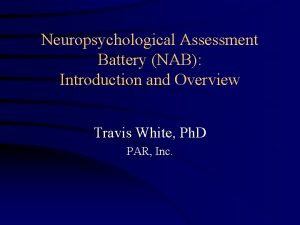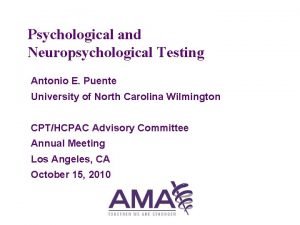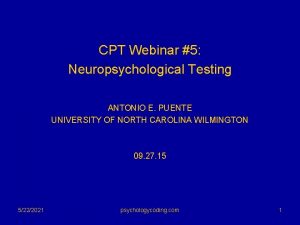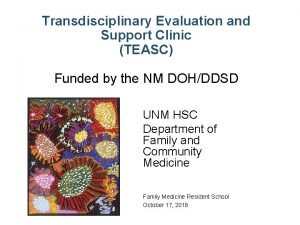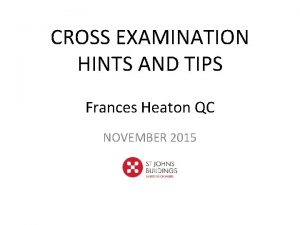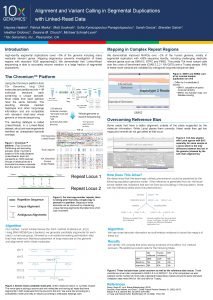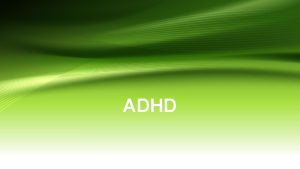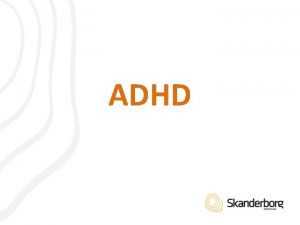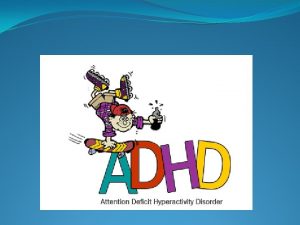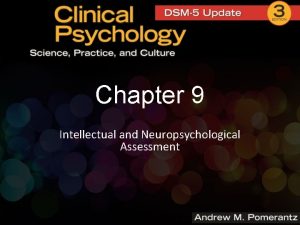ADHD Assessment A Neuropsychological Perspective Shelley Heaton Ph


















- Slides: 18

ADHD Assessment: A Neuropsychological Perspective Shelley Heaton, Ph. D. ADHD Seminar; October 13, 2003

Neuropsychological Perspective n n n Neuropsychology is the “applied science concerned with the behavioral expression of brain dysfunction” (Lezak, 1995) What brain regions may be responsible for the behavioral symptomotology seen in ADHD? How do we measure the functioning of those brain regions – i. e. , how do we measure inattention?

Brain Bases of ADHD § Anatomical and functional neuroimaging studies implicate several brain regions n Frontal Cortex n Corpus Callosum n Cerebellum n Basal Ganglia n Caudate n Putamen n Globus Pallidus “Striatum”

n Neuroanatomy suggests a pathway involving these brain regions known as the “Frontal -Striatal Loop” prefrontal cortex striatum thalimus prefrontal cortex “Striatum” – caudate & putamen (all part of the basal ganglia)

Prefrontal Cortex n n n Region of the brain responsible for monitoring, planning, integrating Structural MRI studies of ADHD have reported smaller volumes of right-hemispheric anterior-superior white matter poorer performances on measurements of sustained attention in ADHD (Semrud-Clikeman et al. , 2000)

Caudate n n n Has been primary site of investigation Reversal of normal brain asymmetry (normal L>R) Smaller left head of the caudate (Semrud-Clikeman et al. )

Caudate Conclusions n n Reversal of caudate asymmetry is related to deficits in response execution tasks in ADHD Caudate dysfunction and hypo-activity of frontal lobes is the primary site of dysfunction

Putamen Previously not the focus of anatomical studies, but… n Symptom specific? n n Subtype specific? n n Changes in structure is likely relate to symptoms of hyperactivity and impulsivity combined type which show more motor problems Disorder specific? n Children with TBI or stroke damage to putamen show secondary ADHD symptoms (Max et al. , 2002)

f. MRI Evidence n Functional differences in regions with structural dysfunctions n reduced activity in the frontal-striatal region Correlated with impaired performance on a response inhibition task n Methylphenidate n n increased frontal-striatal activity increased performance on response inhibition tasks n (Vaidya et al. , 2001) Decreased in blood flow to the caudate in ADHD (Castellanos, 1997; Peterson, 1995).

Implicated Neurotransmitters n Dopamine (DA) n Norepinephrine (NE)

Dopamine & ADHD n Dopamine Hypothesis of ADHD: Dopamine is disrupted in fronto-striatal circuit Dopamine is lower in ADHD n Treat with dopaminergic drugs n Methylphenidate increased levels of DA in synapse n Ritalin inhibits DA reuptake transporters n

Brain-Behavior Relationship n Fronto-striatal circuitry is disrupted, both functionally and structurally. n n n frontal cortex is responsible for inhibition of attention and behavioral responses to salient but off task events basal ganglia is responsible for the motor response to these interfering events Disruption of dopamine regulation in fronto-striatal circuit leads to decreased dopamine release & blunted response of receptors, resulting in behavioral presentation seen in ADHD

Measuring the ADHD Behavior Neuropsychology n Implicate deficits in frontal lobe functions n n n n Attention Disinhibition of behavioral responses Working memory Planning Verbal fluency Perseveration Motor frequency “Executive Dysfunction” and “Inattention”

A Look at the Tests n Disinhibition of behavioral responses n n Working memory n n FAS Perseveration n n Arithmetic, Digit Span, Trails Verbal fluency n n Stroop, CPT, Go No-Go WCST, Trails (B) Motor frequency n CPT

Neuropsychology – The Tests n How do we measure “ATTENTION”? n Multidimensional Construct n Multiple tests CPT n Trails n TEA-Ch n

Domains of Attention Focused/Selectively focusing on target stimuli while ignoring non-target stimuli Sustained Maintaining attentional focus over time (extended) Controlled/Switching Shifting or controlling attentional processes, either by inhibiting a prepotent response or changing response according to environ. cues

ADHD and Attentional Domains n What would we expect? Selective attention? n Sustained attention? n Controlled/switching attention (i. e. , executive function)? n

Measuring Attention as a Multidimensional Contruct Test of Everyday Attention for Children (TEA-Ch) Sky Search Map Mission
 Shelley heaton
Shelley heaton Neuropsychological evaluation example
Neuropsychological evaluation example Nab neuropsychological assessment battery
Nab neuropsychological assessment battery Neuropsychological testing examples
Neuropsychological testing examples Cpt code 96118 neuropsychological testing
Cpt code 96118 neuropsychological testing Teasc
Teasc Heaton moor health centre
Heaton moor health centre Jeff heaton github
Jeff heaton github Frances heaton qc
Frances heaton qc Kathleen vanin
Kathleen vanin Chafford hundred medical center
Chafford hundred medical center Haynes heaton
Haynes heaton How to draw stairs in 2 point perspective
How to draw stairs in 2 point perspective Silo perspective vs business process perspective
Silo perspective vs business process perspective Shelley curran
Shelley curran Mary shelley frankenstein summary
Mary shelley frankenstein summary Percy shelley childhood
Percy shelley childhood Ozymandias rhyme scheme
Ozymandias rhyme scheme Frankenstein chapter 3-5
Frankenstein chapter 3-5
